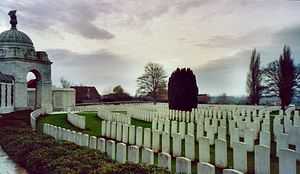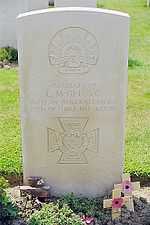Tyne Cot
| Tyne Cot | |
|---|---|
| Commonwealth War Graves Commission | |
 | |
| Used for those deceased 1917–1918 | |
| Established | October 1917 |
| Location |
50°53′13.39″N 02°59′52.54″E / 50.8870528°N 2.9979278°ECoordinates: 50°53′13.39″N 02°59′52.54″E / 50.8870528°N 2.9979278°E near Passendale, West Flanders, Belgium |
| Designed by | Sir Herbert Baker |
| Total burials | 11,954, of which 8,367 are unnamed |
| Unknown burials | 101 |
| Burials by nation | |
| |
| Burials by war | |
|
World War I: 11,954 | |
| 1914 – Here are recorded the names of officers and men of the armies of the British Empire who fell in Ypres Salient, but to whom the fortune of war denied the known and honoured burial given to their comrades in death – 1918[1] | |
| Statistics source: CWGC | |
Tyne Cot Commonwealth War Graves Cemetery and Memorial to the Missing is a Commonwealth War Graves Commission (CWGC) burial ground for the dead of the First World War in the Ypres Salient on the Western Front. The cemetery grounds were assigned to the United Kingdom in perpetuity by King Albert I of Belgium in recognition of the sacrifices made by the British Empire in the defence and liberation of Belgium during the war. It is the largest cemetery for Commonwealth forces in the world, for any war. The cemetery and its surrounding memorial are located outside of Passendale, near Zonnebeke in Belgium.
The name "Tyne Cot" is said to come from the Northumberland Fusiliers seeing a resemblance between the German concrete pill boxes, which still stand in the middle of the cemetery, and typical Tyneside workers' cottages – Tyne Cots.[2]
Tyne Cot Commonwealth War Graves Cemetery
The cemetery lies on a broad rise in the landscape which overlooks the surrounding countryside. As such, it was strategically important to both sides fighting in the area. The area was captured by the 3rd Australian Division and the New Zealand Division, on 4 October 1917 and two days later a cemetery for British and Canadian war dead was begun. The cemetery was recaptured by German forces on 13 April 1918 and was finally liberated by Belgian forces on 28 September.[3]
After the Armistice in November 1918, the cemetery was greatly enlarged from its original 343 graves[3] by concentrating graves from the battlefields, smaller cemeteries nearby and from Langemark.[1]
The Cross of Sacrifice that marks many CWGC cemeteries was built on top of a German pill box in the centre of the cemetery, purportedly at the suggestion of King George V, who visited the cemetery in 1922 as it neared completion.[1] The King's visit, described in the poem The King's Pilgrimage, included a speech in which he said:We can truly say that the whole circuit of the Earth is girdled with the graves of our dead. In the course of my pilgrimage, I have many times asked myself whether there can be more potent advocates of peace upon Earth through the years to come, than this massed multitude of silent witnesses to the desolation of war.—King George V, 11 May 1922[4]
The cemetery was designed by Sir Herbert Baker. The land on which the cemetery stands is the free gift in perpetuity of the Belgian people to those who are honoured here.[5]
Notable graves
The cemetery, being so large, has a correspondingly large number of notable graves and memorials, including the grave of Private James Peter Robertson, a Canadian awarded the Victoria Cross for bravery in rushing a machine gun emplacement and rescuing two men from under heavy fire. He was killed saving the second of these men on 6 November 1917.[1]
Another recipient of the Victoria Cross buried in the cemetery is Captain Clarence Smith Jeffries, an Australian who led an assault party and rushed one of the strong points at the First Battle of Passchendaele on 12 October 1917, capturing four machine guns and thirty five prisoners, before running his company forward again. He was planning another attack when he was killed by an enemy gunner.
The personal message at the foot of the headstone of Second Lieutenant Arthur Conway Young is much commented upon. The message reads "Sacrificed to the fallacy/That war can end war"[1]
Also at Tyne Cot, behind the Cross of Sacrifice which was constructed on top of an old German pillbox in the middle of the cemetery, there are 4 German graves, buried alongside commonwealth graves. These graves mark the men that were treated here after the battle, when the pillbox underneath the main cross was used as a Dressing Station for wounded men. After the battle, men that died of wounds were buried at the rear of what is now the Cross of Sacrifice. These graves are in a much more random arrangement compared to the rest of the cemetery.
Tyne Cot Memorial to the Missing
.JPG)
The stone wall surrounding the cemetery makes-up the Tyne Cot Memorial to the Missing. Upon completion of the Menin Gate memorial to the missing in Ypres, builders discovered it was not large enough to contain all the names as originally planned.[6] They selected an arbitrary cut-off date of 15 August 1917 and the names of the UK missing after this date were inscribed on the Tyne Cot memorial instead.[7] Additionally, the New Zealand contingent of the Commonwealth War Graves Commission declined to have its missing soldiers names listed on the main memorials, choosing instead to have names listed near the appropriate battles. Tyne Cot was chosen as one of these locations.[8] Unlike the other New Zealand memorials to its missing, the Tyne Cot New Zealand memorial to the missing is integrated within the larger Tyne Cot memorial, forming a central apse in the main memorial wall. The inscription reads: "Here are recorded the names of officers and men of New Zealand who fell in the Battle of Broodseinde and the First Battle of Passchendaele October 1917 and whose graves are known only unto God".[9]
The memorial contains the names of 33,783 soldiers of the UK forces, plus a further 1,176 New Zealanders.[10] It was designed by Sir Herbert Baker, with sculptures by Joseph Armitage and Ferdinand Victor Blundstone, who also sculpted part of the Newfoundland National War Memorial.[11]
The memorial was unveiled on 20 June 1927 by Sir Gilbert Dyett.[11]
Gallery
-

Graves at Tyne Cot Cemetery
-

Lewis McGee's grave
-
View towards entrance of cemetery
-

Tyne Cot Cemetery with "Cross of Sacrifice" on the far right
-
The inscription on the cross built upon the largest of the three pillboxes reads:THIS WAS THE TYNE COT BLOCKHOUSE CAPTURED BY THE 3RD AUSTRALIAN DIVISION
4 October 1917
It originally read "2nd Division" until corrected in the 1990s.[1] -

Tyne Cot "Cross of Sacrifice"
-
-
-
Cite error: There are <ref> tags on this page, but the references will not show without a {{reflist}} template (see the help page).
References
- ↑ 1.0 1.1 1.2 1.3 1.4 "Tyne Cot Cemetery, Zonnebeke, Ypres Salient Battlefields, Belgium". Greatwar.co.uk. Retrieved 2011-11-21.
- ↑ Holt, T and V Major and Mrs Holt's Battlefield Guide to the Ypres Salient Barnsley:2003 Leo Cooper Pen and Sword ISBN 0-85052-551-9; p78
- ↑ 3.0 3.1 "Tyne Cot Cemetery". Commonwealth War Graves Commission. Retrieved 2011-11-21.
- ↑ John McGivering, Ed. (20 October 2008). "Notes to "The Debt"". The Kipling Society. Retrieved 2011-11-21. This is the speech written by Rudyard Kipling for the King, and delivered on 13 May 1922 at Terlincthun Cemetery, Boulogne, as reported in The Times of 15 May 1922. The speech was composed by Kipling, who met the King on 11 May near Vlamertinghe, but it is not clear whether the same speech was delivered at cemeteries visited by the King before the closing visit of the pilgrimage at Terlincthun Cemetery. The Tyne Cot information centre attributes the quote to a visit to Tyne Cot on 11 May.
- ↑ "Tyne Cot British Military Cemetery". The First World War Poetry Digital Archive, Oxford University. Retrieved 2011-11-21.
- ↑ (Holt, p29)
- ↑ (Holt, p125)
- ↑ (Holt, p28)
- ↑ "The Tyne Cot Memorial to the Missing". Greatwar.co.uk. Retrieved 2011-11-21.
- ↑ "Ypres: Tyne Cot Cemetery". Trabel.com. Retrieved 2011-11-21.
- ↑ 11.0 11.1 Tyne Cot Memorial, Commonwealth War Graves Commission, accessed 7 February 2010
External links
- Memorial:
- Cemetery register: Details
- Reports
- Plans
- Photographs. CWGC.
- Cemetery:
- Cemetery register: Details
- Reports
- Plans
- Photographs. CWGC.
- CWGC entry for the Memorial
- Silent Cities
- ww1cemeteries.com
- ww1battlefields.co.uk
- 360° Panoramic view
- Tyne Cot Memorial (Belgian heritage register)





